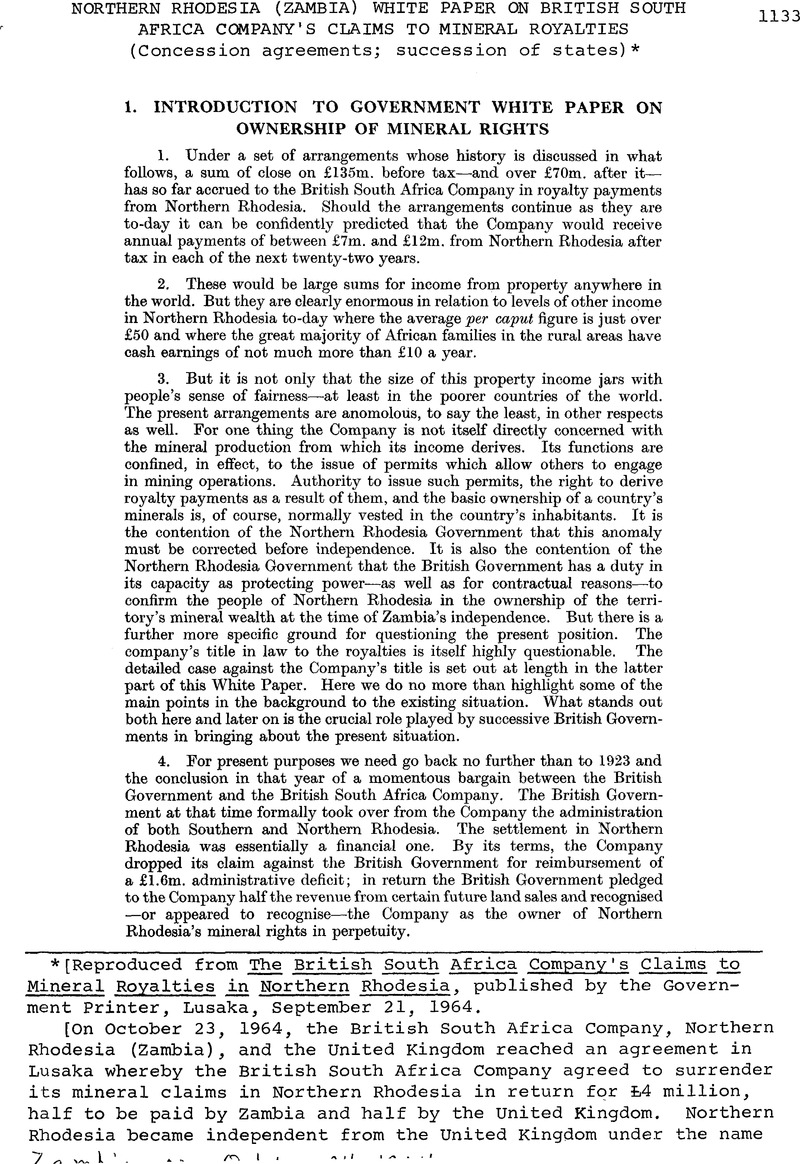No CrossRef data available.
Article contents
Northern Rhodesia (Zambia) White Paper on British South Africa Company's Claims to Mineral Royalties (Concession agreements; succession of states)*
Published online by Cambridge University Press: 18 May 2017
Abstract

- Type
- Report
- Information
- Copyright
- Copyright © American Society of International Law 1964
Footnotes
[Reproduced from The British South Africa Company’s Claims to Mineral Royalties in Northern Rhodesia, published by the Government Printer, Lusaka, September 21, 1964.
[On October 23, 1964, the British South Africa Company, Northern Rhodesia (Zambia), and the United Kingdom reached an agreement in Lusaka whereby the British South Africa Company agreed to surrender its mineral claims in Northern Rhodesia in return for L4 million, half to be paid by Zambia and half by the United Kingdom. Northern Rhodesia became independent from the United Kingdom under the name
References
* But it is far from clear whether this Foreign Office sanctioning or approval really enhanced the status of the treaties. R. H. Meade, a civil servant closely involved in the whole sanctioning issue commented in 1892 “ the signification of such approval adds nothing to what is conceded to the company by the agreement but is only a condition precedent to the exercise of administrative powers if such are given by the agreement “. In the case of the Thomson treaties administrative powers were not, of course, granted to the company.
† The dates of the fourteen Thomson Treaties in 1890 are 10th, 15th and 22nd September; 4th, 11th, 16th, 18th and 26th October; 6th, 12th, 22nd, 15th, 25th and 27th November. Each of the two treaties on 25th November were signed with a chief named Chavira. I t is not clear whether the same man is meant. But Thomson’s reported speed from place place is such as to call in question the claim that the “ headmen and people were gathered together and present on each occasion “.
* This was not the only controversial piece of contemporary map-making in connection with the alleged extent of Lewanika’s domains. The preparation of Mr. MacDonald’s despatch coincided approximately in time with the settlement in 1938 of a long-standing dispute between the then Paramount Chief of the Barotse, Yeta III, and the B.S.A. Company. The details of the dispute are not directly relevant here. What is important is that the settlement documents included an agreed map. Mr. MacDonald, as Colonial Secretary, was duly requested to sanction the settlement in accordance with the B.S.A. Company’s Charter. This he eventually agreed to do but only on the understanding that “ no inference is to be drawn from the map … as to the extent of the Lewanika concessions on 17th October, 1900, and 11th August, 1909, and that no admission is made as to the accuracy of the map in this connection “.
A correction has been issued for this article:
Linked content
Please note a has been issued for this article.


